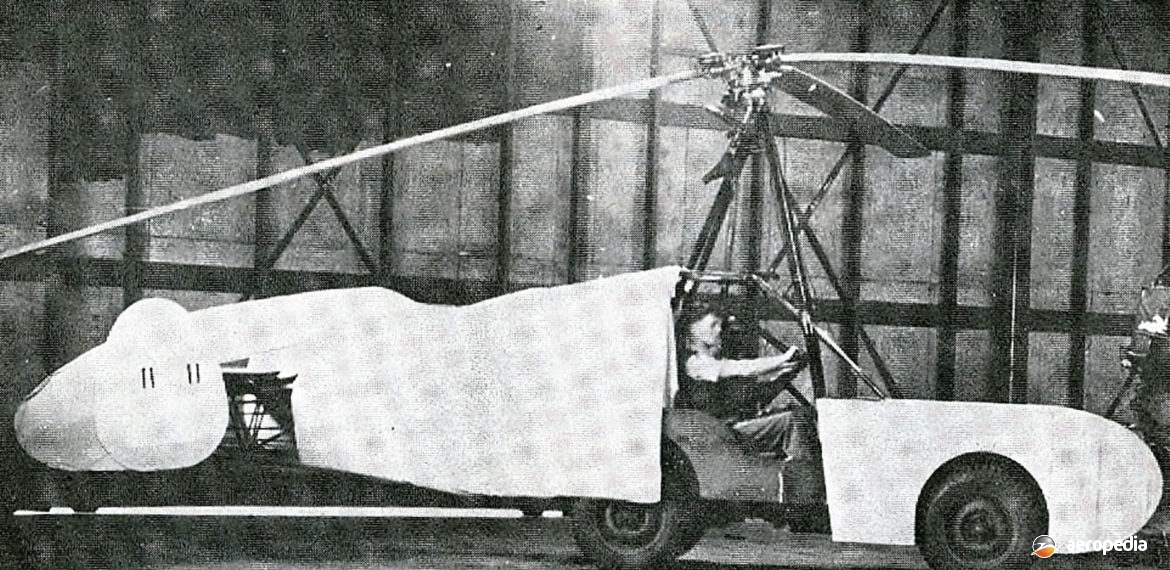Photograph:
The DCA Fleep prototype (Keith Isaacs collection)
Country of origin:
Australia
Description:
Rotary wing military glider
Power Plant:
Specifications:
- Rotor diameter: 13.11 m (43 ft)
- Height: 3.56 m (11 ft 8½ in)
- Length [excluding rotor]: 7.47 m (24 ft 6 in)
- Wheel track: 1.24 m (4 ft 1 in)
- Blade chord: 27.9 cm (11 in)
- Blade pitch angle: 4 deg 36 min
- Tailplane area: 1.94 m² (20.9 sq ft)
- Fuselage tail fin area (upper): 0.77 m² (8.25 sq ft)
- Fuselage fail fin area (lower): 0.32 m² (3.41 sq ft)
- Rudder area: 0.47 m² (5.1 sq ft)
- Jeep road weight with two men and equipment: 1,225 kg (2,700 lb)
- Flying weight: 1,497 kg (3,300 lb)
History:
Known as Project Skyward, work upon which commenced during World War II in March 1943, the DCA Fleep, as it was known, was a conversion of a Willys 4 x 4 ¼-ton Jeep to accept a gyrocopter head so it could be flown to battle areas. The idea was to deliver motor vehicles to the fighting troops in the jungle areas of New Guinea. The army requested the development of a vehicle which could land in small cleared areas, often at the bottom of a valley or ravine, surrounded by steep walls.
The aeronautical engineering group of the Department of Civil Aviation (DCA), headed by John L Watkins, studied the feasibility of such an idea. It was felt a rotor-equipped jeep could fit the requirement, the machine to be towed behind a Douglas C-47 Dakota. At that time three un-airworthy Cierva C-30As were available (VH-USQ, VH-USR, and VH-UUQ) to provide components. However, it was found that the rotor on the C-30A became violently unstable in flight above 169 km/h (115 mph) and the proposed machine would need much higher speeds for safe operation.
A new series of rotors was designed, the first being 13.11 m (43 ft) in diameter. A simple but light removable flying structure was built to fit a Jeep, being attached at four points to allow a quick release. A rotor starting power unit was designed to operate off the Jeep’s own motor through a power take-off from a Ford amphibian truck. The rear end of a C-30A from the head-rest was removed and attached to the Jeep, but a new tailplane and end-plate were built.
After some six months of development, a new rotor with a new aerofoil section had been completed, and some 135 drawings had been prepared. The prototype was in the assembly stage at Essendon, VIC. At this stage arrangements were in hand to commence flight testing behind a Douglas Dakota and the project team was awaiting commencement of test flying when the project was cancelled, the reason given being that the Army’s New Guinea campaign had proceeded so well that there was no longer such a requirement.
It is interesting to note a similar vehicle was designed in the United Kingdom. In April 1942 the Rotary Wing Section of the Airborne Forces Experimental Establishment at Ringway in Manchester submitted a similar proposal, its vehicle to be a Willys Truck 5-cwt 4 x 4 Model MB, to be towed at 257 km/h (160 mph), have a 15 m (50 ft) rotor, and a weight of 1,588 kg (3,500 lb). In the event the Hafner Rotabuggy, using a Jeep, was in fact built and test flown but did not go into production.
Hafner also submitted a similar idea for towing a Valentine tank weighing 15,876 kg (35,000 lb) behind a Handle Page Halifax but in the event none of these promising projects entered the production stage.

